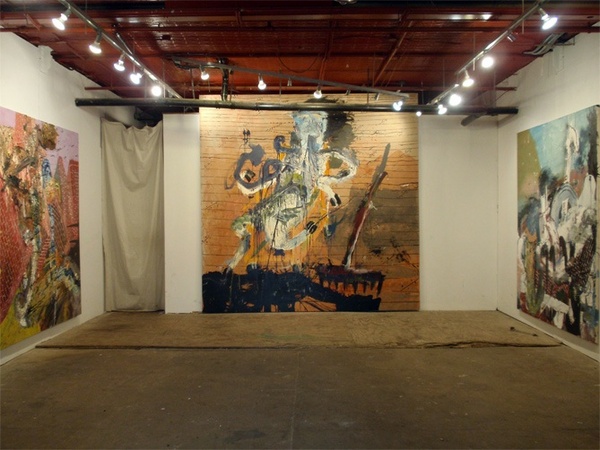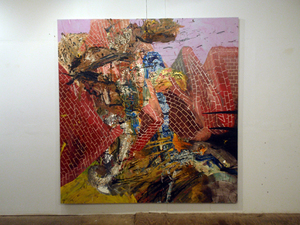This is an archive of the ArtCat Zine, 2007-2009. Please visit our new project, IDIOM.
Andy Piedilato at English Kills
Andy Piedilato
English Kills - 114 Forrest St, Brooklyn NY
10 January - 15 February 2009 (Update: extended through Saturday 22 February 2009)
Andy Piedilato's paintings exude a sensuous formal tension between two rival patterns. Subdued grid-like architectural structures reckon with clouds of multi-chromatic painterly smoke that surround, cover or conceal them. These wild clouds with their flourishes of multi-layered color envelop a brick chimney in one picture. Another picture casts this "smoke" as a painterly blizzard assailing a stone castle's tower.
Piedilato embraces an underlying composition that resembles images of the dragon in Asian art. The monster's scales form one cubic pattern that is juxtaposed against the circular flourishes of its breath of fire. It's a yin-yang between the meticulous organization of linear lines and the chaotic explosions of the curvilinear, between a heavy solid and a formless gas. Such polar opposites attract because they allow us to appreciate the singularity of each pattern by simultaneously experiencing its opposite so immediately. It's like an optical chocolate orange or a retinal sweet and sour sauce.
Clouds of painterly smoke or haze have a long history in 20th century abstract art. But contemporary painters sometimes follow Pollock's example too closely. Many unequivocally embrace his homogeneous approach to covering the entire picture place with one "consistently chaotic" pattern. This oxymoron in words signals a danger in the visual. Joan Mitchell, Gerhard Richter and Anselm Kiefer have striven to fend off this risk of boring formal monotony. By interspersing his color clouds with architectural grids, Piedilato's polychromatic smoke appears scarce and precious rather than overabundant and worthless. The chaos does actually seem like chaos instead of just its own kind of order.
Andy Piedilato paints in the dark. He admitted that under dim light, he finds it easier to paint over certain passages of the smoke that he might otherwise want to keep. The overriding principle is striking a balance between lighter and darker values, between highlights and shadows. This skeleton of chiaroscuro arranges the muscles of his colors so they flex more fiercely. Piedilato approaches color like a chiropractor. Although he may aggressively thump and prod different sections with various layers of messy hues, he never looses sight of the underlying structure of light and dark.
The intensely thick facture in each painting is beyond the grasp of low resolution web reproductions. This rich texture grabs the viewer in every picture with its mountains, valleys and flowing rivers. Piedilato is one more link in the wider trend of art that screams out with its facture. In an era when online imagery substitutes for experiences in the flesh, his painting fights back with tactile confrontations that the Internet can't rival.
The artist remarked to your commentator that "I paint with a huge sense of hopefulness. I don't have an idea but I like the idea of finding one – an awesome idea you have for a picture will not be as awesome as the one you find." It's an ethos of seizing upon the serendipity of the process rather than falling back into tired routines or painting from mental boiler plates.
The tough aspect of this carpe diem approach is that the artist sees his works as series of forks in the road, in which the painting was leading in a few different directions and he wonders whether picked the right path and contemplates its cascading repercussions. But this is a sign of depth. Each painting becomes a deep, long and rewarding conversation with itself. Highly reactive to its own image – each work is charged with the potential of an unstable element as well as the tenacity of self-individuation.
ZINE
HOME
TIPS / COMMENTS
CATEGORIES
CONTRIBUTORS
- Greg Afinogenov
- B. Blagojevic
- Adda Birnir
- Susannah Edelbaum
- Julie Fishkin
- Paddy Johnson
- Jessica Loudis
- Christopher Reiger
- Andrew Robinson
- Peter J. Russo
- Blythe Sheldon
- S.C.Squibb
- Hrag Vartanian


